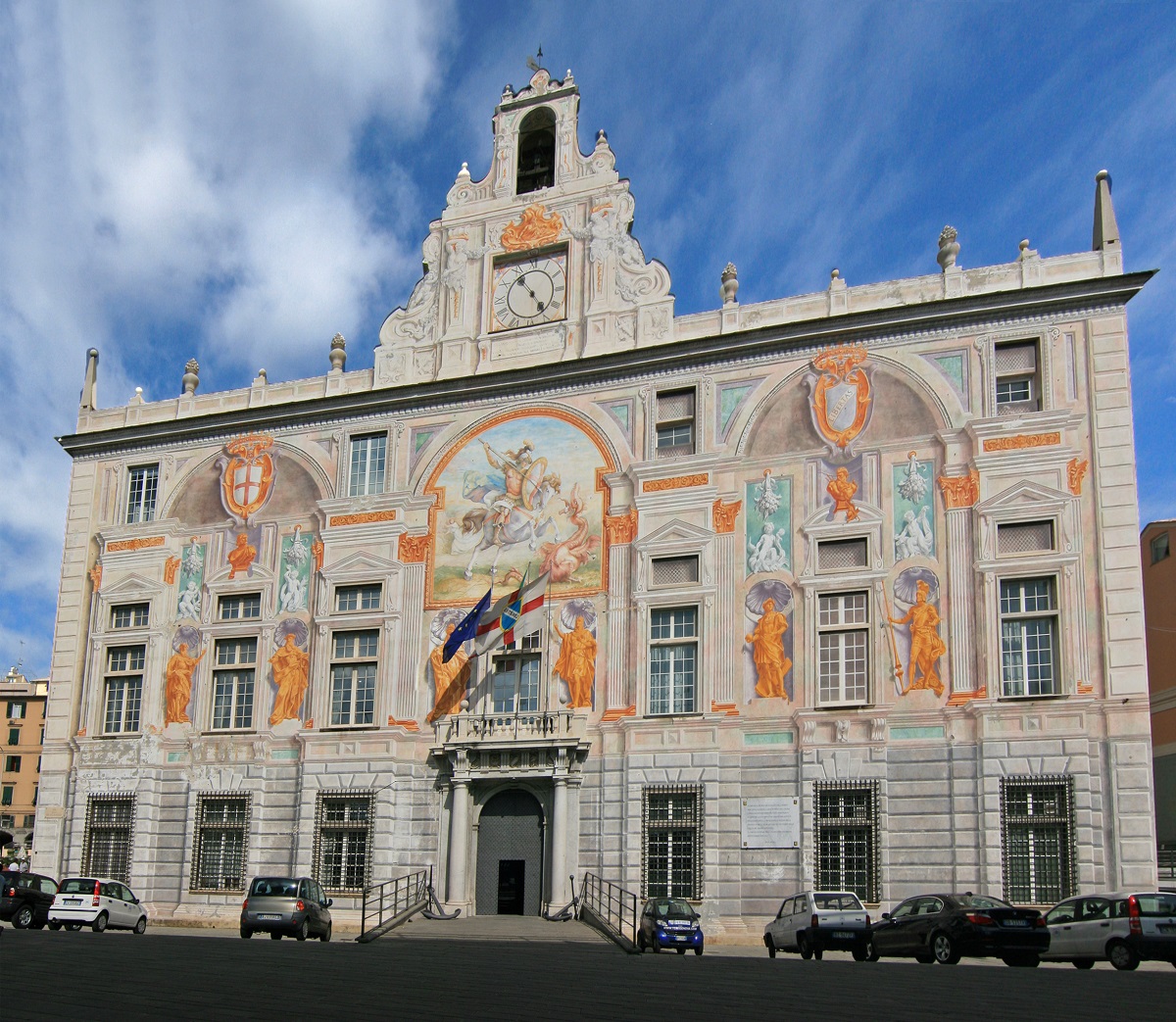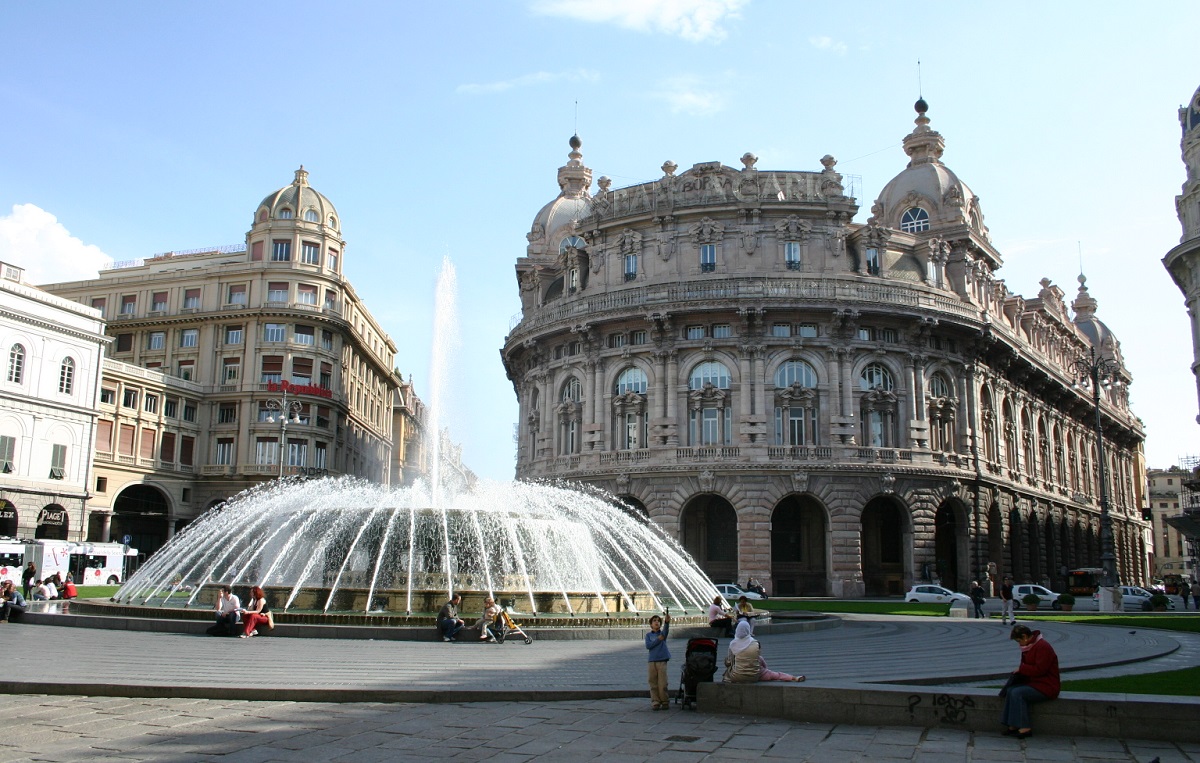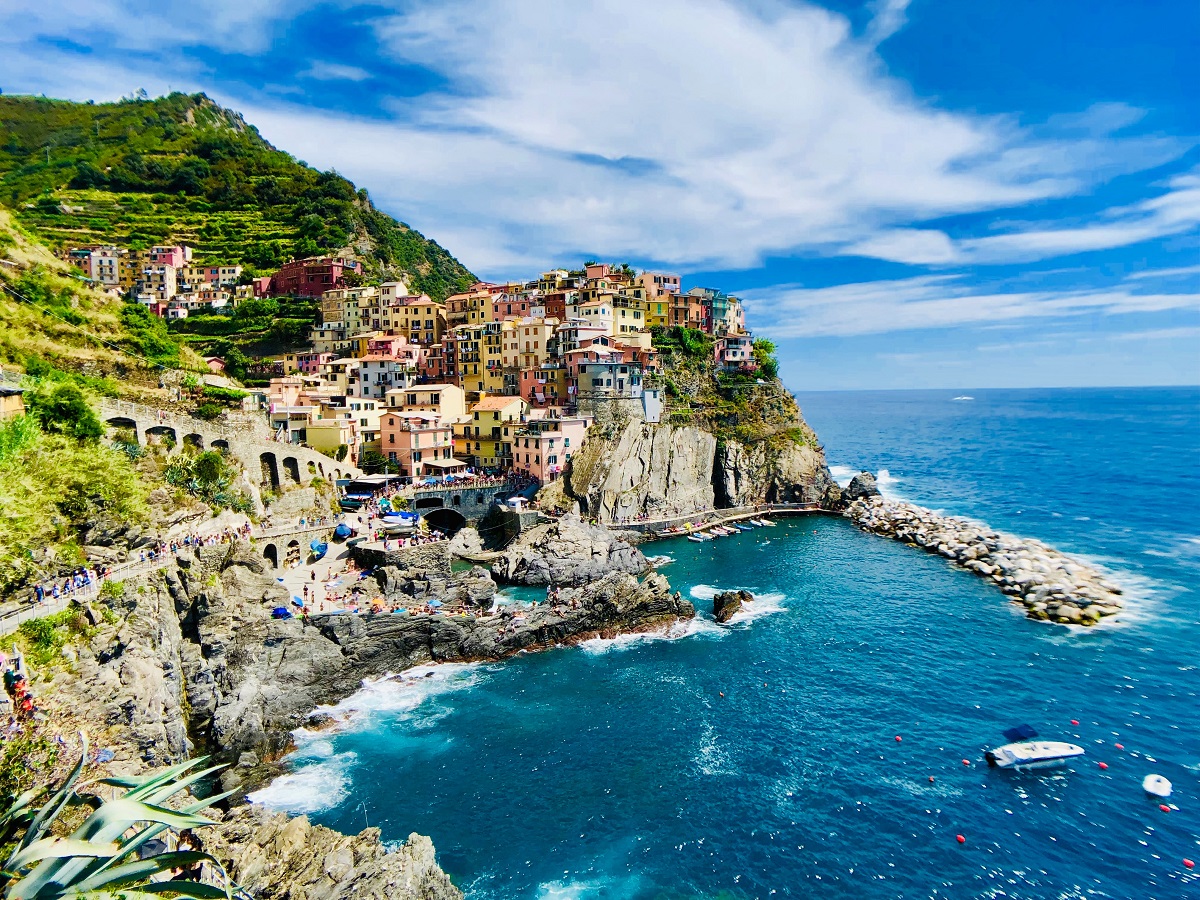Genoa is one of the great and old merchant and trade cities of Northern Italy, and for centuries it was an independent state as the Republic of Genoa. The wealth of this period from trade on the world seas did result in many of the city’s magnificent buildings and sights that you can enjoy today.
A large number of Genova’s distinguished mansions are inscribed on UNESCO’s list of world heritage. The mansions were part of a formal system for receiving important visits during the time of the Republic, and a walk along Via Garibaldi is one of the best places to experience the diversity of the mansion buildings of Genoa’s leading families.
Andrea Doria was one of the city’s well-known inhabitants. As an admiral and politician, he had great impact on the development of Genoa, and his villa is definitely worth a visit too. Christopher Columbus is another celebrity from the city, he was born and raised in Genoa before rediscovering America in 1492.
Genoa also has its beautiful churches, squares, fountains and other sights that make a stroll in the center enriching. The fact that the city is built on a heavily hilly terrain only makes the experience even better when you, for example, enjoy one of many views from the top of town.
You can also visit the beautiful Ligurian coast around the city, where you will find Portofino and the Cinque Terre National Park. The small towns are quaint and picturesque villages between mountains and the waves of the Mediterranean. Larger cities like Italian Turin and French Nice are easily accessible as well.












The early settlements
Genova’s natural harbor, mild climate and strategically good location have, over time, been the subject of housing and development. The Greeks colonized the area in the 400-500 BC, but possibly the Etruscans were here before then. The town was called Stalia, and the rivals in the area were settlements in today’s Marseille and Vado Ligure. Stalia was later drawn into the Punic wars during which Carthage destroyed the city in 209 BC. as a result of an alliance with Rome.
From Roman to Lombard and Franks
The Roman Empire was dominant in the Mediterranean for centuries and thus also in Genoa, whose name comes from the Latin word genu, meaning knee. The word and the name refer to the city’s location on the Ligurian coast.
With the fall of the Western Roman Empire, the Goths came into being and established the East Gothic Empire in the year 493. It covered modern Italy well and existed until 553, when the Byzantine Empire triumphed out of the Gothic War.
In 568 the Germanic platoons invaded the Italian territory, and in this connection Milan’s bishop fled to Genoa, where he established his seat with the support of the Pope. The Lombards, however, quickly penetrated south to Liguria, which they conquered in 643. The Lombard kingdom consisted of 773, when the Franks took over.
Over the following centuries, it went up and down Genoa. The Franks rebuilt the city’s fortress walls, which had been established by the Romans and destroyed by the Lombards. Another devastation hit the town in the 930s, when Muslim North Africans looted and burned the city that was not immediately rebuilt.
The Republic of Genoa
In the following centuries, several urban states emerged in the Italian territory, and among them was the Republic of Genoa, which together with Venice became the strongest and most wealthy of these entities. Genoa was formally subject to the Pope, who, through the city’s bishop, had an official political leader of the city and state.
The real power, however, lay with the number of consuls appointed through election among the voters of the inhabitants. They were elected annually and oversaw the development of the city, which was not least its strength as a major maritime city with shipbuilding, trade and a financial sector as an economic driving force. Genoa built a large fleet and became a great power at sea. On land, the Republic grew to include, among others, Liguria, Piedmont, Corsica and Sardinia today. After the Fourth Crusade of 1202-1204 and the resulting tensions between the State of Venice and the Byzantine Empire, Genoa could even establish itself in the Black Sea with possessions and settlements in Crimea.
The alliance with and the good relationship with the Byzantine Empire meant new prosperity for the city, which together with Pisa was the only one with commercial rights on the Black Sea. A fortunate alliance with Aragon’s rule in Sicily provided further trade and revenue.
Fall of the Republic
The good times did not last, and from the end of the 1300s began the recession of the Republic of Genoa, which had been in a long battle against Venice. In 1380, Genoa was defeated by the Venice Navy during the Battle of Chioggia, and it became the turning point for worse times for the rich city-state. At the same time, the rising Ottoman power affected Genova’s lucrative trade on the Black Sea.
The low point was from the mid-1400s, when France and Aragon fought for influence in the Italian territory. Following threats from the King of Aragon, Genoa’s doge left the city to France in 1458, and Genoa’s new status became the duchy of France. This time, however, only lasted until 1461, when the republic was re-established; this time with support from Milan. Just three years later, Milan itself took power in Genoa, and until the beginning of the 16th century, power changed repeatedly. French control and looting were part of the agenda until the 1520s.
It was also during these bad times from Genoa that Christoffer Columbus was born and grew up in Genoa. He came to the world in 1451, and as a young man traveled to Portugal and Spain, from which he later set out on his expedition, which led to the European rediscovery of America in 1492. Columbus donated funds to a house in his native Genoa, where always had a house where members of his family could spend the night.
Andrea Doria and the splendid mansions
In Genoa, many wealthy and influential families lived. One of them was the Doria family, in which Andrea Doria was born in 1466. He came to play a major role for Genoa when, from 1522, he was in French service against Spain. However, Doria broke up with French King Francis I after disagreement over the future of Genoa, and with Spanish help he liberated Genoa from France. In 1528 he was able to reintroduce the dog government to the city and thereby the republic. Without becoming a political head of state, Andrea Doria, until his death in 1560, was Genova’s leader, and during the period 1531-1555 he was also admiral of the Habsburg Navy.
Andrea Doria’s close ties to German-Roman Emperor Karl V also provided support for the re-establishment of the Republic of Genoa. In 1528, Doria granted the first loan to the emperor through the Genovese banks. The banks brought in staggering fortunes from not least discrete financial transactions in the Spanish empire, and part of the wealth was exchanged for the many splendid mansions erected in central Genoa; they continue to stand side by side in the streets of Via Garibaldi and Via Balbi.
The final years
The Republic‘s power, prosperity and influence were constantly minimized throughout the 17th century, and it infected Genoa and Genovese banks that had made big money in Spanish business. Weak Spain also had physical consequences, with France bombing Genoa in 1684. About 13,000 cannonballs are believed to have fired against the city from the French navy.
In the 18th century, the downturn for Genoa continued. In 1742, the city lost its last remote possession in the Mediterranean; it was the island and fort of Tabarka in present-day Tunisia.
In 1745, Genoa was forced into the Austrian Succession War with support to France and Spain to avoid the Kingdom of Sardinia’s expansion into the Republic of Genoa. In 1746, however, the city had to surrender to the Austrians, who were, however, thrown back on the gate just to initiate a siege in 1747. In the wake of the defeat, Corsica disbanded in 1755, and as Genoa failed to retain power on the island, the city-state chose to relinquish Corsica to France in 1768.
1797 was the end of the century-old republic. Napoleon’s successful French troops occupied the city and created the French-controlled Ligurian Republic. In 1805, this republic was incorporated in France and divided into departments. Genoa liberated itself in 1814, when British troops also came to the city and proclaimed the reintroduction of the Republic of Genoa. However, the formal result of the Napoleonic era became the result of the Vienna Congress, which decided that Genoa should belong to the Kingdom of Sardinia, which annexed Genoa on January 3, 1815.
Nineteenth-century Genoa and Italy
The Kingdom of Sardinia in 1815 consisted of both the island of Sardinia and Piedmont just north of Genoa, and for the Genoese there were economic benefits to the new state formation.
Despite favorable trade opportunities, however, there was opposition among the city’s citizens to the foreign monarchy that ruled the former republic. Thoughts and genovesian independence, however, ended bloody when it came to bombing by the local administration and civilians from days 5-11. April 1849. King Vittorio Emanuele II had sent General Alfonso La Marmora to the city to quell a rebellion, and on April 5 he launched a full 36 hours of bombing. The city resisted the pressure until April 11, when upwards of 30,000 troops invaded Genoa.
After the defeat, Genoa fought for an Italian rally, which could create greater political weight and at the same time increase freedom in an expanded kingdom. In 1860, the later national hero, General Giuseppe Garibaldi, started from Genoa with over a thousand volunteers aiming to conquer southern Italy and start a unification of the country. Garibaldi was the front figure of Risorgimento, a movement for just Italian unity. Garibaldi conquered Sicily and won the Kingdom of Naples, and it became the starting point for the entire Kingdom of Italy.
The latter half of the 19th century was a period of great new growth in Genoa. The importance of the harbor continued to grow with more expansions and new yards, and the railways also came to the city this time with several large plants in the 1850-1860s. New city plans with major streets and modern buildings and institutions also popped up on an ongoing basis.
The 20th century to today
As the end of the 19th century, the beginning of the 20th century was also a time of strong expansion and great growth in Genova’s population. New streets and squares were constructed; eg the magnificent Piazza della Vittoria as a memorial to the First World War. Corso Italia along the Mediterranean was built, and with it the city could expand along the coastline. A symbol of the city’s and country’s ability and prosperity was also the skyscraper Torre Piacentini, who rose from 1935 to 1940 as Europe’s highest of its kind.
With its large port and associated industry, Genoa became a frequent ally bombing target during World War II. The bombings occurred both from the sea and from the air, but despite the devastation and the Italian defeat of the war, Genoa recovered quickly after the war. The city was part of the Northern Italian economic engine, concentrated on the cities of Milan, Turin and Genoa.
In recent years, Genoa has been the center of major events several times. In 1990, football matches were played during this year’s World Cups, held in Italy; moreover, the first metro train in the city ran the same year. Two years later, there was Genoa Expo ’92 in the city, and here the city’s prestigious aquarium also opened as one of Europe’s absolute leaders. In 2001 there was a G8 meeting in the city, and in 2004 Genoa was the European Capital of Culture. Culture and tourism are today an essential industry and visitors have a wealth of experiences to choose from; Among them are Genova’s distinguished mansions, which are listed on UNESCO’s World Heritage List.
Overview of Genoa
Genoa is one of the great and old merchant and trade cities of Northern Italy, and for centuries it was an independent state as the Republic of Genoa. The wealth of this period from trade on the world seas did result in many of the city’s magnificent buildings and sights that you can enjoy today.
A large number of Genova’s distinguished mansions are inscribed on UNESCO’s list of world heritage. The mansions were part of a formal system for receiving important visits during the time of the Republic, and a walk along Via Garibaldi is one of the best places to experience the diversity of the mansion buildings of Genoa’s leading families.
About the upcoming Genoa travel guide
About the travel guide
The Genoa travel guide gives you an overview of the sights and activities of the Italian city. Read about top sights and other sights, and get a tour guide with tour suggestions and detailed descriptions of all the city’s most important churches, monuments, mansions, museums, etc.
Genoa is waiting for you, and at vamados.com you can also find cheap flights and great deals on hotels for your trip. You just select your travel dates and then you get flight and accommodation suggestions in and around the city.
Read more about Genoa and Italy
Buy the travel guide
Click the “Add to Cart” button to purchase the travel guide. After that you will come to the payment, where you enter the purchase and payment information. Upon payment of the travel guide, you will immediately receive a receipt with a link to download your purchase. You can download the travel guide immediately or use the download link in the email later.
Use the travel guide
When you buy the travel guide to Genoa you get the book online so you can have it on your phone, tablet or computer – and of course you can choose to print it. Use the maps and tour suggestions and you will have a good and content-rich journey.
Grand Palazzos • Columbus • Via Garibaldi • Porto Antico • Andrea Doria
Overview of Genoa
Genoa is one of the great and old merchant and trade cities of Northern Italy, and for centuries it was an independent state as the Republic of Genoa. The wealth of this period from trade on the world seas did result in many of the city’s magnificent buildings and sights that you can enjoy today.
A large number of Genova’s distinguished mansions are inscribed on UNESCO’s list of world heritage. The mansions were part of a formal system for receiving important visits during the time of the Republic, and a walk along Via Garibaldi is one of the best places to experience the diversity of the mansion buildings of Genoa’s leading families.
About the upcoming Genoa travel guide
About the travel guide
The Genoa travel guide gives you an overview of the sights and activities of the Italian city. Read about top sights and other sights, and get a tour guide with tour suggestions and detailed descriptions of all the city’s most important churches, monuments, mansions, museums, etc.
Genoa is waiting for you, and at vamados.com you can also find cheap flights and great deals on hotels for your trip. You just select your travel dates and then you get flight and accommodation suggestions in and around the city.
Read more about Genoa and Italy
Buy the travel guide
Click the “Add to Cart” button to purchase the travel guide. After that you will come to the payment, where you enter the purchase and payment information. Upon payment of the travel guide, you will immediately receive a receipt with a link to download your purchase. You can download the travel guide immediately or use the download link in the email later.
Use the travel guide
When you buy the travel guide to Genoa you get the book online so you can have it on your phone, tablet or computer – and of course you can choose to print it. Use the maps and tour suggestions and you will have a good and content-rich journey.






Similar to Genoa Travel Guide
There are no listings matching your search.
Reset